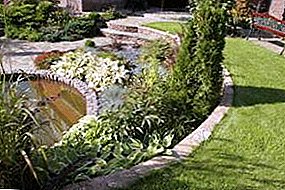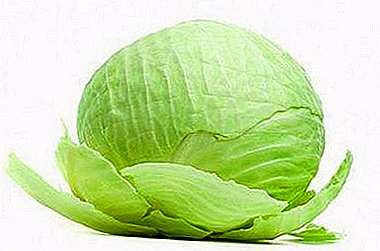
We have already told about the organization of the relationship of the garden plot and the house, how to divide the plot into zones and create a "multi-level".
We mentioned the role of the fence in the design of the garden plot. Today let's talk about the composition, shape and color.
Mistake 1. Faddie geometry
 One of the principles of landscape design is the rule of repeating motifs.
One of the principles of landscape design is the rule of repeating motifs.
Based on this principle, some gardeners, having a rectangular area, all other elements of the garden are also equipped with smooth lines.
Paths make straight, lawn - square.
Professionals working in the field of landscape design, adhere to an absolutely opposite rule..
They create new forms that go against the classical ideas about geometry. A strong contrast creates a feeling of "denial" of the existing form of the garden.
On an elongated and narrow area, uneven elements should prevail, for example, the tracks can be placed diagonally or in an arc, without corners.
The preference of a particular method depends on the idea and style of the site.:
- if according to the plan an element of the correct shape should be located on the plot, choose a rhombus instead of a square.
Change shape with the help of smooth and soft lines, behind which the eye will slide more slowly. Arrange a round platform for rest, without resorting to a rectangle, arrange the path diagonally;
- if you prefer a landscape layout, round smooth lines that form sinuous shapes come to your rescue. Get inspiration from nature. Make irregularly shaped paths with meanders, rest area is irregularly shaped with waves and ovals.
If it is not possible to organize a landscape path, you can make a "fake" by building unusual transitions. In a small area often create the illusion of such a track with the help of various materials. They alternate in an interesting way (but not staggered). The impression of tortuousness creates a contrived paving pattern.
The methods proposed above relate to flower beds, flower beds, large plants that serve as decorative sculptures, lawns and ponds. Front lawn is recommended to do in the form of an arc or tape. You can resort to the creation of arbitrarily curved lawn.
Objects that decorate the site, have a free scheme, without resorting to a direct trajectory. Smooth, rounded lines remove sharp corners from the site and visually increase the garden space.
Accessories for the site are also selected on the principle of "opposite". This method is resorted to at will or as needed, if, for example, there are too narrow or sharp zones.
Error 2. There is no composition on the plot.
 The term "composition" is known to everyone, but not everyone knows that when organizing the space of a garden plot, you also need to build a certain composition.
The term "composition" is known to everyone, but not everyone knows that when organizing the space of a garden plot, you also need to build a certain composition.
Students of design departments have been studying composition for five years - this concept is so extensive.
Compositional construction is not a symmetry, the selection of accessories of the same color or classic style.
Composition is the science of how to correctly position objects in the garden so that everything looks aesthetically and beautifully.
In some people, there is an instinctive pursuit of a composition. For example, the choice of clothes, the ability to dress is also an element of the compositional structure.
Any composition is built around a specific center, which is a large, catchy object that one cannot but pay attention to.
The center is differently called the active dominant because it attracts the eye with color, shape, structure, bright or delicate shades, originality or singularity. In this case, the central structure can be located on any territory of the site.
The composition includes the proportional ratio of objects in relation to each other. If this principle is violated, it seems that each object is taken from another place, thereby disturbing the harmony of perception.
How can proportionality be kept:
- correctly plan the site. For a big house to pick up large gazebos, large trees and other elements. Objects in the garden of a small house, respectively, should not be huge;
- resort to special tricks and tricks. If on a small plot there is already a large house, it is worth visually increasing the size of the land.
Compositional principles apply to specific distances. Before installing the objects, be sure to estimate which objects will stand side by side or be placed in the same composition. Accuracy is required, up to centimeters. This question is relevant if you decide to add another item to an existing group.
Here the principle of the golden section will help. It is used to create any work of art. Calculate it is not easy, but possible, if you understand its definition.
Error 3. Incorrectly used color
 Mistake is very common because the garden contains a large number of shades.
Mistake is very common because the garden contains a large number of shades.
Plantings of different colors play a big role.
Some people think that the most important thing is to plant more bright multi-colored plants. It's a delusion.
The combination of colors should be harmonious:
- nuance harmony involves the use of different shades of the same color;
- tonal harmony - the use of different, but related colors;
- contrasting harmony - using opposite contrasting colors.
In each case, the matching of two, three or four colors is possible. There is a separate group of neutral shades that balances brightness. These include beige, light yellow, gray, sand, cream and others.
In daylight, only warm tones are not distorted. For this reason, it is recommended to plant plants of “warm” flowers in the sun, and “cold” plants in the shade. During the day, the lighting on the street changes, so it is important to pay attention to how the shade looks in different light.
Unsaturated colors are used to create background designs, and with the help of bright shades they place accents. A color collage will help determine the color range: a photo of a garden is glued to a large sheet of paper and samples of paints and other materials are applied to the garden.












